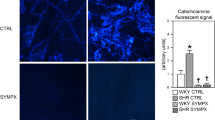Abstract
THE physiological importance of enzymes that degrade angiotensin in plasma and in tissue extracts has been questioned by Johnson and Ryan1. They have shown that aqueous extracts of rabbit liver hydrolyse all the peptide bonds of Asp1-Ile5-angiotensin II amide and Asp1-Val5-angiotensin amide when incubated at pH 7.4 and 37° C. There is also evidence that the liver plays an active part in the destruction of angiotensin in vivo2–5. Bumpus et al.2 have shown that the liver of nephrectomized rats infused with tritiated angiotensin accumulates more labelled peptide fragments than do other organs. Chamberlain et al.3 found a smaller rise in the blood pressure of four dogs and two humans when Asp1-Val5-angiotensin amide was infused into the portal venous system than when it was infused into the femoral vein. It is difficult to interpret their results because full details of the techniques used are lacking, and it is not clear how the doses were matched against each other. Hodge et al.4 have measured concentrations of angiotensin in circulating blood both before and after passage through various tissues in anaesthetized dogs. They find a marked decrease in the concentration of angiotensin after passage through the liver, as shown by the change in response of the isolated gut preparations used to assay angiotensin in their experiments.
This is a preview of subscription content, access via your institution
Access options
Subscribe to this journal
Receive 51 print issues and online access
$199.00 per year
only $3.90 per issue
Buy this article
- Purchase on Springer Link
- Instant access to full article PDF
Prices may be subject to local taxes which are calculated during checkout
Similar content being viewed by others
References
Johnson, D. C., and Ryan, J. W., Biochim. Biophys. Acta, 160, 196 (1968).
Bumpus, F. M., Smeby, R. R., Page, I. H., and Khairallah, P. A., Canad. Med. Assoc. J., 90, 190 (1964).
Chamberlain, M. J., Browse, N. L., Gibson, D. G., and Gleeson, J. A., Brit. Med. J., ii, 1507 (1964).
Hodge, R. L., Ng, K. K. F., and Vane, J. R., Nature, 215, 138 (1967).
Methot, A. L., Meyer, P., Biron, P., Lorain, M. F., Lagrue, G., and Milliez, P., Nature, 203, 531 (1964).
Author information
Authors and Affiliations
Rights and permissions
About this article
Cite this article
LEARY, W., LEDINGHAM, J. Pressor Response to Infusion of Angiotensin into the Portal Vein of the Rat. Nature 220, 180–181 (1968). https://doi.org/10.1038/220180a0
Received:
Issue Date:
DOI: https://doi.org/10.1038/220180a0
Comments
By submitting a comment you agree to abide by our Terms and Community Guidelines. If you find something abusive or that does not comply with our terms or guidelines please flag it as inappropriate.



